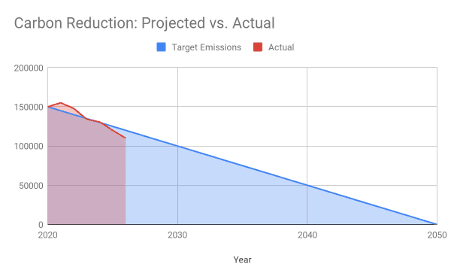
Carbon Reduction Plan
Prepared in accordance with the Carbon Reduction Plan Guidance.
Commitment to achieving Net Zero
BGTS is committed to achieving Net Zero emissions by 2050.
Baseline Emissions Footprint
Baseline emissions are a record of the greenhouse gases that have been produced in the past and were produced prior to the introduction of any strategies to reduce emissions. Baseline emissions are the reference point against which emissions reduction can be measured. This is for the baseline reporting period of 1 January 2024 to 31 December 2025.
Baseline Year: 2024
We are committed to reducing our carbon footprint and achieving Net Zero emissions by 2050. As a responsible business, we recognise the importance of sustainability and environmental stewardship in all aspects of our operations.
Baseline year emissions
| Emissions | Total (tCO₂e) |
|---|---|
| Scope 1 | 2.20 |
| Scope 2 | 3.25 |
| Scope 3 (Included Sources) | 13.69 |
| • Business Travel | 8.15 |
| • Employee Commuting | 5.53 |
| • Upstream transportation and distribution | 0.00 |
| • Downstream transportation and distribution | 0.00 |
| • Waste generated in operations | 0.00 |
| Total Emissions | 19.13 |
There are no Upstream transportation and distribution and Downstream transportation and distribution, and Waste generated in operations is zero due to us not manufacturing and distributing physical goods.
Emissions reduction targets
Scope 1 – Direct Emissions
Our Scope 1 emissions total 0.00 tCO₂e for the 2024 reporting period. This reflects our operational model where we primarily operate from serviced office spaces and have transitioned our fleet to electric vehicles. Our service-based business model inherently results in lower direct emissions compared to manufacturing or industrial organisations.
Scope 2 – Energy Indirect Emissions
Our Scope 2 emissions total 3.25 tCO₂e, representing 19.2% of our total carbon footprint. While we do not have access to detailed electricity consumption data due to our serviced office arrangements, we have developed robust estimates based on industry benchmarks and operational data.
- Office electricity consumption has been estimated at 2.17 tCO₂e based on typical UK office energy consumption patterns. With three employees working from our office facilities, we have applied an industry-standard benchmark of 3,500 kWh per employee per year, totalling 10,500 kWh annually.
- Electric vehicle charging represents 1.07 tCO₂e of our Scope 2 emissions. Based on operational data for our Tesla vehicle, which travels 28,800 kilometres annually, we have estimated electricity consumption using typical Tesla efficiency of 0.18 kWh per kilometre.
Scope 3 – Other Indirect Emissions
Our total Scope 3 emissions for 2024 are 13.69 tCO₂e, representing 80.8% of our total organisational emissions. Business travel is the largest source at 8.15 tCO₂e, primarily from international flights. Land-based travel and employee commuting are also significant contributors.
Progress against targets (chart)

Carbon Reduction Projects
Carbon Reduction Initiatives
- Fleet transition to electric vehicles (e.g. Tesla)
- Flexible working policies (avg. 22.5 hours/week from home)
- Rail travel prioritised over air for domestic trips
- Use of high-quality video conferencing tools
Planned Future Measures
- Sub-metering for accurate electricity tracking
- Renewable electricity procurement (target: 100% in 3 years)
- Virtual-first meeting policy and carbon budgeting for travel
- Incentives for electric/hybrid vehicles & public transport
- Supplier engagement and low-carbon logistics planning
Reduction Targets and Timeline
| Timeline | Targets |
|---|---|
| Short-term (2025–2027) |
|
| Medium-term (2028–2035) |
|
| Long-term (by 2050) | Net Zero across all scopes |
Approval & Signature
Signed on behalf of the Supplier:
Suman Alamsetti
Director
Date: 01 January 2025




